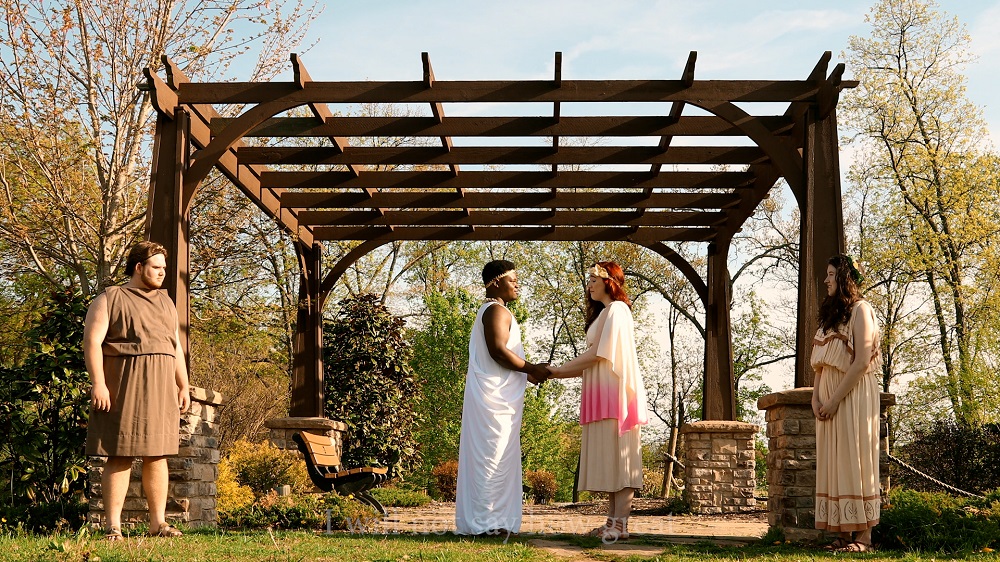Murray State University's Department of Music presents Monteverdi opera L'Orfeo
By Viola Torkornoo | Aug 17, 2021

MURRAY, Ky. — The Murray State University Department of Music’s Opera Theatre Ensemble recently presented its first fully virtual opera production. The production, titled “L’Orfeo”, was under the direction of Dr. Maribeth Crawford, associate professor of music, voice and opera.
L'Orfeo is the title of the Monteverdi opera, which is an early opera. It was first written in 1607 and is the earliest opera that is still frequently performed to this day. L'Orfeo is based on the Greek tragedy of Orpheus. It is about Orpheus' descent into the underworld to bring his dead wife, Eurydice, back to the living world. He is allowed to go to her with one exception: he may not look at her. Overcome with his love for Eurydice, he breaks the law of the underworld, and looks at her, causing him to lose her forever.
While COVID restrictions and guidelines prevented the University campus and greater community from organizing and participating in various events during the spring semester, the circumstances rather inspired the title selection for this opera.
“I chose this opera because it seemed to be the best option through COVID,” said Crawford. “All of the vocal parts, with the exception of the Greek Chorus sections, are solos. I was able to work with students individually, even remotely, on their parts. We then recorded the voices separately, allowing us to follow all of the COVID restrictions. After all of the recordings were completed, students then lip synced their parts for the filming, mostly outside, to limit the expelling of respiratory droplets.”
“Artistically, I wanted to create something very natural. We used locations on the Murray State campus, the Arboretum and Clarks River to give it an organic feel,” added Crawford. “Murray State has many structures that have Greek architectural elements, such as columns and a sense of order and symmetry. Most of the scenes shot in the ‘living world’ have these types of elements, as evident in the locations used and the blocking of the actors. The wedding scene is a perfect example of symmetrical spacing with the actors. They are spaced symmetrically and create several visual ‘pictures’ that promote balance. In contrast, the underworld scenes were filmed at Clarks River. We used a wall with graffiti as our backdrop and much of the blocking was uneven and disproportionate, to signify the turmoil and unease of the situation. One other element that was under great consideration was the lighting. We had to be sure to choose times for each location to help portray each setting. You will notice that the prologue and wedding is during the day, and the scenes in the underworld get gradually darker as Orfeo travels deeper to find his dead bride. With the help of Dr. Heidi Ortega, costume designer in the theatre department, we were able to costume each student in Greek inspired costumes.”
“As the costume coordinator of the production, I assisted Dr. Crawford in selecting and designing the costumes for the production,” said Dr. Heidi Ortega, associate professor and costume designer in the Department of Music. “I also served as the costume technician for this production and I worked on any and all needed repairs and alterations to the costumes to prepare for the production. While all regular COVID protocols were adhered to, one of the major safety measures put in place was that fittings for the actors were scheduled and I waited 24 hours after fittings to begin work on any item that had been handled by an actor.”
Work on the production started in January and final edits were done by the week after the spring semester concluded in May. Much of the beginning rehearsals were dedicated to getting the Italian diction as accurate as possible. This took a lot of time because Monteverdi wrote in what is called recitative style, meaning that the solos have a feeling of natural speech inflections.
“There is a lot of text, so there were many Italian words to get used to!” said Crawford. “This was one of the biggest challenges, but the students worked hard and were very successful.”
“I had a team of faculty who helped me with this project,” said Crawford. “Heidi Ortega helped with costumes, Justin Patton helped with sound design, and Jeremy McKeel and his team helped with video production and editing. We had several props that we borrowed from the theatre department, and Marci Jo Gardner-Edmonds, from Playhouse in the Park, designed and made our lyre, which was used in the prologue. Min-Kyo Jung played our electronic harpsichord for the soloists and Dr. Jack Dressler played for the Greek Chorus sections. Dr. Brad Almquist rehearsed and prepared the chorus. I am very grateful for their support and help.”
“I am also extremely proud of the student performances and the overall quality of the sound and video production,” added Crawford.
L’Orfeo, presented by Murray State University’s Department of Music, can be viewed at https://youtu.be/PdtI0hfclwY.
“Even though we would probably not be performing this particular production in the near future, we have a number of other productions lined up for this fall,” said Crawford. “The University’s Opera Theatre Ensemble will be performing Seymour Barab's Little Red Riding Hood later this fall, October 29 and 30. Seymour Barab’s Little Red Riding Hood is a children's opera in one act. It is in English and an operetta (hybrid between musical theatre and opera in style).”
